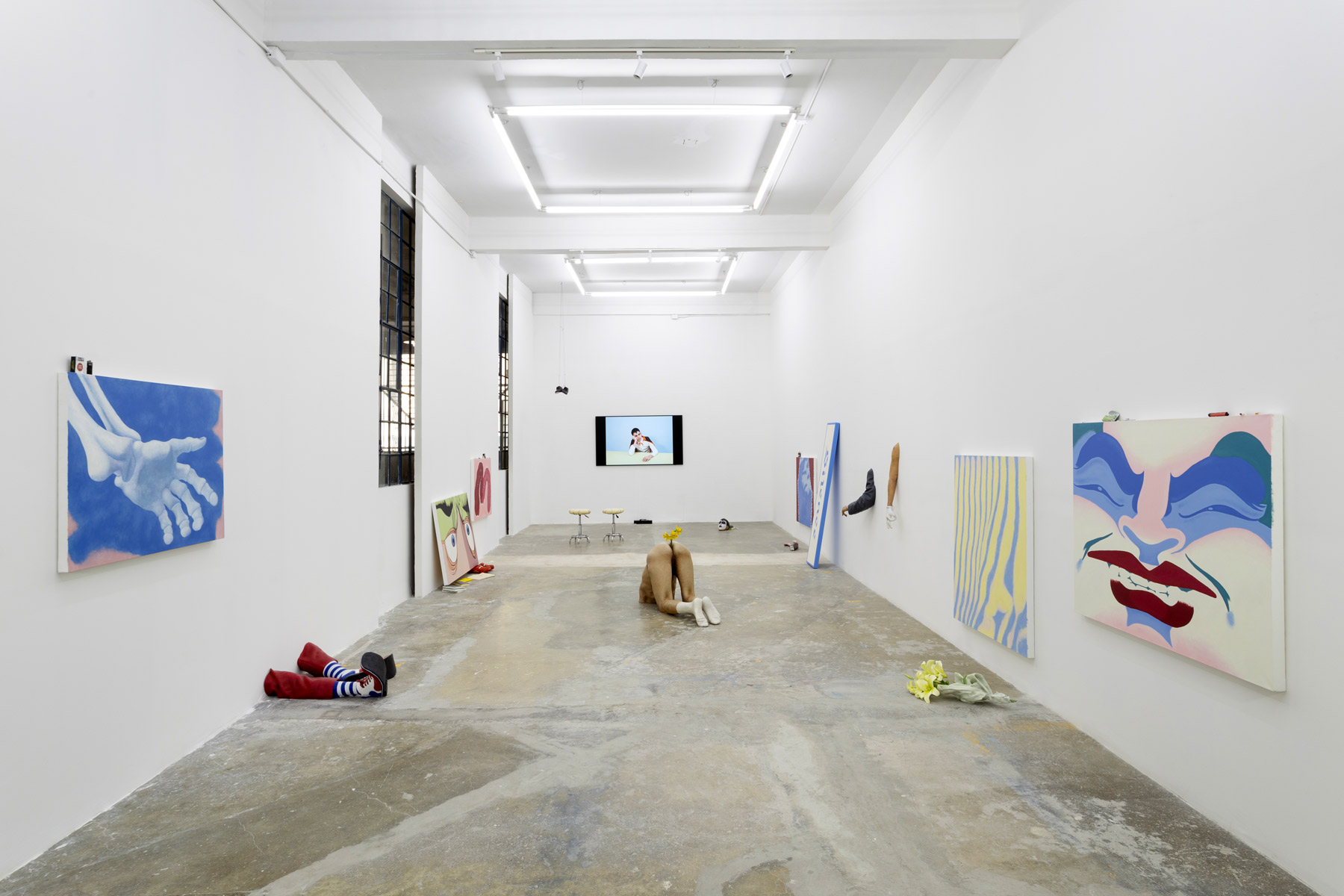


Curatorial work and text by Gaby Cepeda
This exhibition is all about repetition and failure, about the Sisyphean trial and error that constitutes both the universal experience of performing adulthood and a life consecrated to art making: the risks and triumphs, the shame and the assurance, the impostor syndrome versus the main character syndrome. The artworks here give form to the artist’s corpus and to his own identity and vice versa, they’re entwined, reflections of each other, duplicates in a series of objects intimately linked, unfolding in the space in ‘mo- ments’ intended to emphasize what binds them: artifice—the fiction of ourselves that overflows into art, and the simulations of art that overwhelm and alienate us from first contact.
The show has a clear center, El otro protagonista de la noche (The other protagonist of the night, 2025), a series of sixteen video vignettes allegorizing the very common narrative of the coming-of-age, the road paved with anxiety and insecurities that supposedly leads to adulthood. The negotiation of earnestness and performance that informs the series starts with ‘applause’, the artist shakily balancing his whole body on the scarce, frivolous and fickle currency of the title; it is followed by ‘dream’ one of few encounters with the self that is another, rivalry and comparison, the enemy in the mirror. The passages are succinct, artificial, experiences synthe- tized into symbols: Chiquidrácula, Michael Jackson, mainstream masculinity (its toxicity, but also its seductiveness), the disobedi- ence that wears a business suit, the clown mask, and also the sensible mask, the rebellious, the formal and proper masks we’re all made to wear at some point in our lives. The titles progress in a narrative that insists in the illusion of stability and balance (the alternating carrot and stick) yet end up revealing the system’s dedication to refining its methods to make us all fall.
López Llamas’s previous preoccupations—the individualistic logic that props up both the pharma-obsessive pathologizing of the people who somatize the world’s dysfunctionality, as well as our reverence for the uniquely crazy geniuses of art history—continue to resonate in his practice, but today they are no longer directed by a purely biographical approach, instead they march towards the archetypical, universal distillations from the hyper-personal: the visualities incarnated by masculinity, the reiterative glitz of celebrity, the idle touring of a psyche plagued with sticky adolescent memories, the canonical moments of pop culture, the images that educate and challenge us, that simultaneously humiliate and empower us.
Even when exploring new psychic regions, López Llamas doesn’t wander off from painting, although he does mean to exceed its limits by pushing unruly pictorial representations: it is there in the videos, in its careful treatment of color, in its cinematographic quoting via art historical compositions; it’s there in the sculptures laying around the space, hand painted replicas of the artist’s accessories, his props, tools, materials, costumes and vices; and it is most definitely, although in a state close to torpor, in the paint- ings that also reflect, imitate, what the videos already exploit. Painting itself exists here in the backdrop, not as mere background, but like those intrusive mental images that knowingly wait for their turn in the warehouse of our memories.
Here, López Llamas is training what the author Alan Dale calls “the collapse of the hero’s dignity” enacted in slapstick comedy, the exaggerated and redundant falling, the unexpected smacking—the pathos of clowning. He also uses the video format in a way that evinces his millennial baggage: the cable re-runs of 80s sketch comedies, the brutal segments of jackass, the hyper-refined aes- thetics of music videos (both products of the MTV high-aughts), the cognitive acceleration of TikTok, the air fryer of our attention span. The artist celebrates and embraces both these aspects, laughing at the misfortune of recognizing oneself as a hodgepodge of ordinary references, mass media products assimilated by everybody else; the dissolution of one’s unicity, of our generation’s myth of being special, of meritocracy shining at the end of the grueling tunnel. Identity and maturity—both artistic and personal—as the result of this painful yet revealing process, the enduring of trial and error, applause and ridicule.